At the best of times, mornings in a family of four are probably exhausting, particularly for women. Ensuring that everyone eats, gets dressed, heads to school or work on time and in one piece can be chaotic. But mornings in a hot Bengaluru without water is downright soul crushing, says Kala, a 38-year-old woman living in Krishnanapalya.
The water shortage in several parts of the city has disrupted the lives of low-income families and put public institutions like schools and hospitals on the edge.
Krishnanapalya lies in east Bengaluru. Unlike the 110 villages in the peripheral areas of the city, Krishnanapalya is an older locality and more urbanised. But it is a neighbourhood with predominantly lower middle class and low-income households. An area where buying tanker water is an unaffordable nightmare.
Erratic water supply
Prabha, a field worker with the Association for Promoting Social Action (APSA), puts me in touch with three women living in the neighbourhood and part of a self-help group. The first thing all three of them tell me independently is that bathing has become a luxury. It weighs on their minds. “We haven’t had any running water the entire day,” says Kala. It is around 3pm when we talk.
Krishnanapalya gets piped Cauvery water but the supply is erratic. Bhavani, also in her thirties, notes, “In the past, Cauvery water would get released for at least an hour everyday. Long enough to fill the storage tanks and last a couple of days. Now, it is released for 20 minutes at most and it’s a trickle. There is no choice but to try for tractors.”
Unaffordable tankers
Tractors or water tankers supplying groundwater to homes are expensive. Amidst complaints of soaring tanker prices and water hoarding, the state government passed an order capping tanker price.
A 12,000 litre tanker supplying water within a 5 km radius of their source can charge up to Rs. 1,000 and Rs. 1,200 while supplying in a 5-10 km radius. Tankers carrying 6,000 litres can charge up to Rs. 600 within a 5 km delivery radius and a maximum of Rs. 750 for delivery beyond 5 km.

Across Bengaluru, individuals, schools and hospitals that I spoke to say these pricing rules are not being followed. In Krishananapalya, the price of a 6,000 litre tanker was Rs. 1,200. In Ratna’s case, one tanker has to be shared between four families in her colony. It hardly lasts a day. “Worse, even if we are willing to pay, the tractors don’t come. We have to call them continuously over a couple of days to get water once,” she says. “If this is our condition, how can poor people living in sheet houses afford this?” asks Kala.
No water to wash
As a result, mornings in the women’s homes have been tense for a while. On the day I spoke to her, Kala’s husband, a social worker, and two children in college and school woke up to find that the house had absolutely no water. “My husband rushed to buy two RO water cans for the morning. Everybody got two mugs of water to wash their face and get ready for the day. I also had to make breakfast and lunch with the same water and wash my hands occasionally.”
Dishes and clothes must wait until Cauvery water is released hopefully at night or a tractor makes its way to her home. Kala’s daughter in the midst of her board examinations was the most upset. “After waking up early and studying the whole day, she wanted to be fresh for her exam in the afternoon. But I couldn’t do anything about it and she left cranky and irritable. Moodu out aag bittide. Our moods are ruined,” says Kala.

Women sacrifice water
But the women, all three of them homemakers, sacrifice the most during the scarcity. As they have the least work outside their homes, they get last preference for baths, clean clothes or even toilets. Bhavani bathes every alternate day while Ratna says she has held out for nearly four days. It is an uncomfortable prospect in the summer heat. The Indian Meteorological Department has predicted a hotter summer in the city compared to previous years.
Kala has perhaps had it worse, because of her period. “It’s a time when you want to wash more frequently and drink lots of water, but we can’t afford to. I don’t know how young girls are going to manage,” she says. Prabha, the field worker who coordinates the self-help group’s activities, listens to the women talk with a knowing smile. She faces the same problems in her home in KR Puram.
Unlike Krishnanapalya, Prabha’s neighbourhood in KR Puram is primarily supplied with groundwater by the Gram Panchayat. “The supply used to be very good,” recalls Prabha. But now they say the borewell is running dry. A Gram Panchayat official told Prabha that the borewell that was dry at depths of 1,500 ft. I could not independently verify this claim.

No help from officials
All the women I spoke to said that no BBMP or BWSSB officials had attempted to visit the area. “We have tried contacting BWSSB about the Cauvery water supply but they just tell us that there is no water to release,” says Kala. No elected representatives have visited the neighbourhood either. Krishnanapalya is part of the CV Raman Nagar assembly constituency with S Raghu from the BJP as the MLA and central Bengaluru Lok Sabha constituency with PC Mohan as the MP. “Everybody comes during elections, but no one cares otherwise,” says Bhavani.
Read more: Water scarcity in Bengaluru: Drowning in problems, thirsting for solutions
None of the women knew about designated BBMP nodal officials for each ward in the city. I tried contacting the nodal officials for the Krishananpalya ward that the women lived in but could not get through. We will update the story with their responses.
Schools, hospitals on the edge
Meanwhile water shortage slowly grips public institutions like schools and hospitals in the city. At Inspire Public School in Thanisandra, school administrator Neha says that the school is being extremely careful with water usage. Thanisandra is one of the 110 villages with no Cauvery connection. “Typically, we can manage with ground water, but this year our borewell went dry by February,” says Neha. The school comprising 300 students currently depends on tankers ordered once in two days.
The 6000 litre tankers cost approximately Rs. 1,500 but tanker owners can charge more explains Neha. Like others, the tankers have to be ordered well in advance. We have an understanding with the tanker owners, but the supply still gets delayed occasionally. “The main issue is that we cannot run out of water in washrooms, with this many students. It would be a mess.”
At Jai Bharat English School in Hegde Nagar, school administrator Chetan Kumar says that the students have been instructed to carry spoons to eat their meals, so they don’t use water to wash their hands. “If students have water left in their bottle at the end of the day, we tell them to water a plant on the campus,” says Chetan.
Water saving measures
Meanwhile school authorities have stopped all non-essential services such as washing grounds, school vans and even daily watering of plants. “Our landscaping is expensive. We are trying to reduce watering plants, but if they die it will be expensive to replace them,” says Neha.
Luckily, the academic year will soon end and the schools will shut down for a couple of months. But hospitals in these areas, which have to run round the clock through summer, are concerned. Sai Hospital in Hegde Nagar ran out of water in their borewell over a month ago. The hospital is currently using around 10 tankers a day. The hospital is relatively small in scale with only 8 doctors and 40-50 outpatients per day.
“We need to keep our toilets and the hospital premises spotless. That means cleaning multiple times a day,” says an administrator who did not wish to be named. “The staff uses lots of water just to wash their hands and scrub up before and after patient examinations,” he says.
Both the schools and the hospital note that the tanker prices have more than doubled since February. “We have no choice but to agree to the rates,” says the hospital administrator. “If we run out of water it will be worse.”

Prabha, the field worker, feels that the crisis has resulted in one positive outcome. “People are more aware now of the importance of saving water and protecting our trees and lakes.” Prabha lives close to the Avallahalli lake also known as Yelle Mellapa Shetty lake. “Now, people are talking about saving that lake and planting more trees,” she says. “It has become a good lesson in the importance of nature.”
How did we get here
Bengaluru gets its water supply from two main sources: groundwater and Cauvery water. Nearly 50% of the city’s water supply is from groundwater and the rest from Cauvery according to this Water Balance report by WELL labs. Groundwater is used for domestic, commercial and industrial activities in the city.
This supply is affected by climate and rainfall patterns. Bengaluru’s rainfall has been steadily increasing over the past few decades. Average annual rainfall has increased from 900 mm in the 1900s to around 1,200 mm in 2000s. The annual rainfall since 2020 has been over 1,200mm. But then we had two big anomalies. In 2022, the city received 1,957mm of rainfall; the highest in 122 years. It was this deluge that caused the 2022 floods. The floods aside, the years of heavy rainfall caused groundwater levels to rise.
However, 2023, was an El Nino year. El Nino is a climatic event caused by warming Pacific winds. El Nino years typically result in droughts or low rainfall for India. And Bengaluru experienced this in 2023. The city and the entire state of Karnataka was in deficit.
This did not affect our groundwater supply in 2023 because the aquifers were full from heavy rains in the previous years. But the groundwater supply dropped by early 2024. The Cauvery water reservoirs are also low because of poor rainfall and loss of forest cover in the region.
Together this has caused a severe water shortage in the city. This shortage is particularly affecting peripheral areas like Mahadevapura, Yelahanka and Bommanahalli, where residents are dependent on groundwater. However, as this report shows, even areas with Cauvery water supply are seeing heavy shortage.
The issue is compounded by the city expanding and consuming more groundwater while our lakes, which catch rainfall and recharge groundwater levels are encroached or dry.